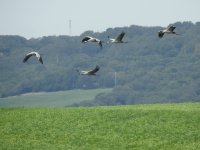John Cantelo
Well-known member
I did, however, briefly visit three small lagunas - Lagunas Juncosa & de los Tercios (Lagunas de El Puerto de Santa Maria) and Laguna Jeli (Lagunas de Chiclana) and spent a couple of hours walking around a fourth, the urban Laguna de Torrox (Jerez). The first had water but was entirely birdless so, being pressed for time, I didn't look at the nearby Lagunas Chica & Salada. However, I was surprised to find that the shallow Laguna de Los Tercios (also shown on maps as the Marismas del Laguna Pozo Lozano or Laguna del Hato Carne) nearby had some water. My very quick look found a few Shovelers, Green Sandpipers, Black-winged Stilts, Flamingos and plenty of gulls. I wouldn't have looked at the (former?) Laguna de Jeli at all were it not for the fact that I wanted to show the general area to a birding friend (it's excellent for migrating raptors and has a small population of Rufous Bushchats later in the year. It was, of course, bone dry.



Perhaps significantly, the only places that seemed to have plenty of water were golf courses and landscaped urban lagunas. Since Laguna Torrox - one of the latter - was in Jerez near IKEA (which I had to visit to buy new bed linen) I managed to take the time to walk around the perimeter of this figure-of-eight laguna (c2 hours). The fact that it had one (or more) Red-knobbed Coot was, of course, entirely incidental ... It had a few pochard (both varieties), Mallard, Purple Swamphen, Great-crested Grebe, Cormorants, masses of Swallows and House Martins, a few Crag Martins, an early Sedge Warbler and, yes, a Red-knobbed Coot. Although there were few ducks and grebes, it was by far the liveliest laguna I visited in Cadiz province.





Perhaps significantly, the only places that seemed to have plenty of water were golf courses and landscaped urban lagunas. Since Laguna Torrox - one of the latter - was in Jerez near IKEA (which I had to visit to buy new bed linen) I managed to take the time to walk around the perimeter of this figure-of-eight laguna (c2 hours). The fact that it had one (or more) Red-knobbed Coot was, of course, entirely incidental ... It had a few pochard (both varieties), Mallard, Purple Swamphen, Great-crested Grebe, Cormorants, masses of Swallows and House Martins, a few Crag Martins, an early Sedge Warbler and, yes, a Red-knobbed Coot. Although there were few ducks and grebes, it was by far the liveliest laguna I visited in Cadiz province.


























